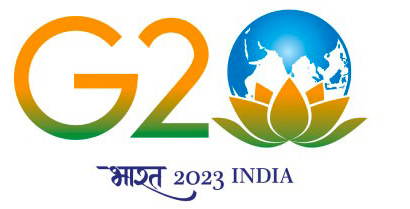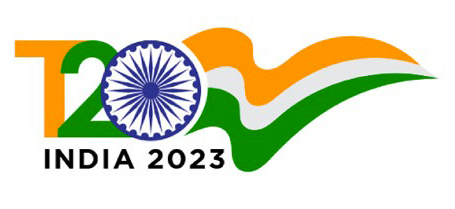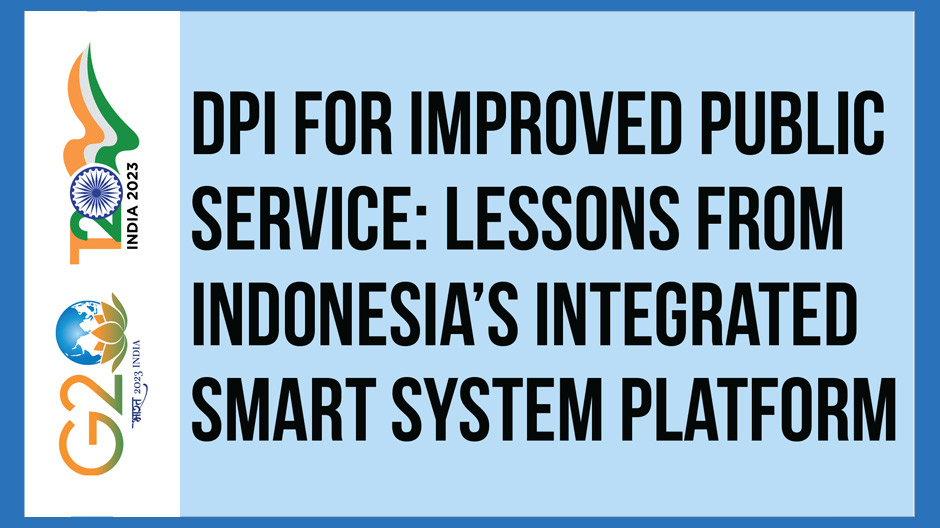Task Force 2: Our Common Digital Future: Affordable, Accessible and Inclusive Digital Public Infrastructure
Like in many other countries in the world, in Indonesia, public and private entities alike use information technology to enhance the delivery of their services. Substantial amounts of data are created in the process—some of them precise, while others may be erroneous. Such inaccuracies require the attention of decision-makers. This Policy Brief highlights the importance of improvement and innovation in the digital public infrastructure (DPI) to ensure that data becomes more reliable and precise, and ensures the efficient management of existing government and private sector services in the country. The integrated smart system platform (ISSP) could be used as a DPI that would integrate and manage data from both the government and private services. With standardised integration, the ISSP architecture would be interoperable with other systems. In addition to ensuring maximum cyber security, the ISSP would utilise microservices to expand its capability and dependability.
1. The Challenge
The use of information technology in public service is based on the primary tasks and functions of such services as outlined by the government. In Indonesia, the problem with utilising information technology is that there are regions that are yet to have adequate technological infrastructure and continue to experience erratic electricity supply and poor internet connectivity. Thus, large proportions of the population do not reap the benefits of digitalisation of public services.
In developing an information technology-based public service system, both government and non-government organisations collect data but are often found wanting due to lack of coordination. This leads to data duplication, inaccuracies, and integrational problems among these multiple data sources. This results in different metadata for the same value data in the government system. Moreover, data that should be identical but are stored in different public service entities are duplicated across institutions, leading to low data quality. The collected data thus is frequently inaccurate, insufficient, and poorly structured. Various factors contribute to this problem, including lack of training of personnel and, therefore, inadequate understanding of the significance of the data, inefficient data management systems, and poor data monitoring and maintenance.
These challenges have negative consequences on the quality of community-wide stakeholder decisions. Inaccurate data leads to inaccurate information, which in turn results in inaccurate knowledge patterns. Wrong knowledge patterns result in inappropriate decisions that are supposed to enhance people’s quality of life. It is therefore crucial to adopt a standardised digital public infrastructure (DPI) to improve data quality.[1]
2. The G20’s Role
Initiated at the G20 Summit in Berlin, Germany, in 2017, the meetings of health ministers of G20 have facilitated discussions on global health issues such as antimicrobial resistance (AMR), public health emergencies, and universal health coverage. In fact, 71 percent of the world’s elderly reside in G20 countries, the majority of whom have a proportional mortality rate from non-communicable diseases that exceeds 70 percent.[2] A large 78 percent of the top 50 pharmaceutical companies in the world are located in G20 nations.[3] The G20 countries, therefore, must pursue collaborative and cooperative approaches that would supplement the roles of the G7 and WHA regarding comparable health problems.
The G20 could, for instance, share their experiences in dealing with the health challenges of the elderly populations, reducing CO2 emissions, prohibiting the production of low-quality medicines, and implementing standardised health check-ups for migrants and refugees for their health information. The G20 countries have the potential to solve global challenges as a group by convening high-level meetings at G20 summits.
3. Recommendations to the G20
The initiative for a DPI investigates and constructs a new, more robust internet for the public good.[4] DPI refers to infrastructure and technology designed to facilitate and support the delivery of public services. DPI consists of the hardware, software, network, and data management systems utilised by the government and other public agencies to provide services to citizens, businesses, and other stakeholders.[5] A DPI could help bridge the digital divide by providing equal access to digital services and information to all citizens, regardless of location or socioeconomic status. In addition, a DPI could help improve the quality and efficacy of public services by facilitating enhanced data sharing, analysis, and decision-making.[6]
Electronic government (e-government) platforms, digital identity systems, online payment systems, and electronic voting systems are examples of DPIs. This system is intended to enhance the effectiveness, openness, and accessibility of public services, as well as the quality of governance as a whole.[7]
The integrated smart system platform (ISSP) is a collection of modules and technologies used for developing, deploying, and operating other applications, procedures, or technologies that deliver smart services. The ISSP consists of essential elements that support the DPI.
1. Data integration
Data integration is a concept that was created to integrate diverse types of data.[8] Using data standardisation as a priority, the ISSP could incorporate data managed by both the public and private sectors. Data integration for a DPI involves data from multiple sources, such as Internet of Things (IoT) sensors, mobile devices, social media platforms, and other digital platforms. The data is collected, cleaned, organised, and analysed for integration to generate knowledge and support decision-making in fields like transportation, energy management, public safety, and healthcare. While integrating data, there is a data guardian led by the communication and informatics service who determines which data is public data and which data is exempt data.
2. Data bridging
Data bridging is the method of connecting multiple sources to facilitate data communication between institutions, for facilitating a simpler and more efficient data exchange between these institutions.[9] Frequently, government agencies and organisations have separate information systems with distinct data formats and data structures. Data bridging could help solve this problem by connecting disparate data systems and resources so that data could be routinely and automatically exchanged between related agencies.
Data bridging requires agreement on the data format, data exchange protocols, and standards applied to ensure interoperability between the involved systems and applications. This could involve the use of APIs (application programming interfaces), cloud-based systems, and other technologies that could facilitate a more efficient data exchange.
3. Data analytics
Regional data analytics is the collection, analysis, and visualisation of regional data using data technology and algorithms. This could aid regions in taking more informed decisions and providing better services to their constituents. In cities, data analytics could be utilised in numerous fields, including transportation, environment, and security. In transportation, data analytics could assist cities in optimising public transportation routes, managing traffic congestion, and enhancing road safety. Data analytics could aid in the measurement and management of air quality as well as waste management.[10]
4. Data visualisation
Data visualisation is the use of various tools, such as graphs, maps, and other visual displays, to present pertinent and essential information that is easily comprehensible and readily accessible. Typically, the physical manifestation of data visualisation is a command centre. The command centre is a centralised control and monitoring centre utilised by government agencies, security agencies, and other organisations that monitor an activity in a specific environment.
Data visualisation in the command centre could enhance the team’s capacity to quickly process information and take appropriate action. Data visualisation could improve the identification and response to security threats. Interactive maps, for instance, could be used to visualise real-time locations of patrol vehicles and other security equipment, making it easier to determine the optimal location from which to respond to an incident.
Figure 1. ISSP Interaction with Other Systems
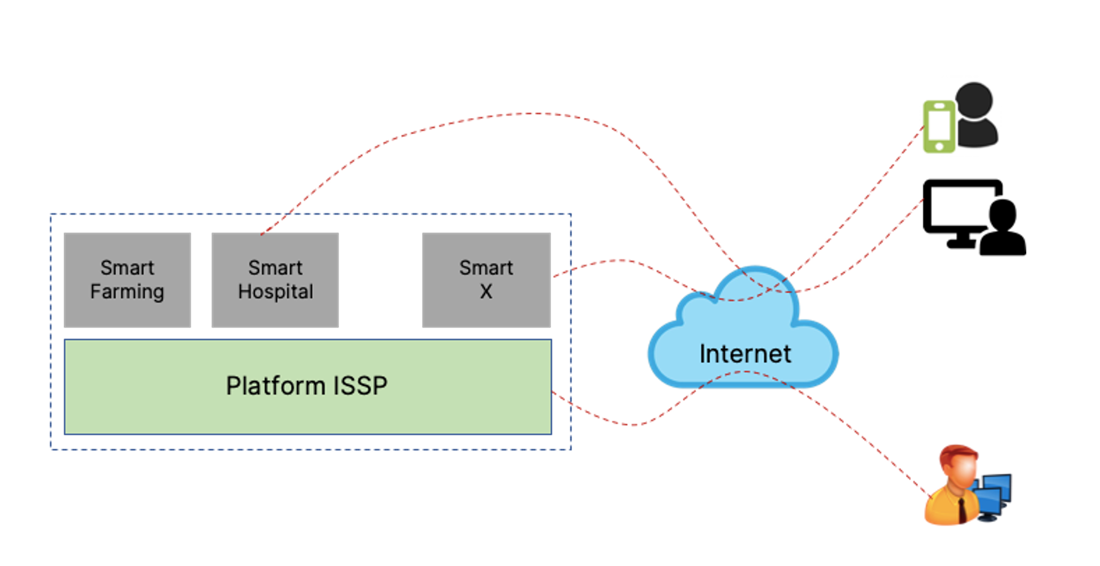
Source: Authors’ own
The essential components of ISSP interact with the systems above it (Figure 1). If any smart farming data is integrated into the ISSP, other systems that are permitted to consume the data may do so. Depending on the region or city, data from other systems integrated into the ISSP could be analysed according to domain-specific requirements. The mortality rate in health is used for implementing the ISSP in this Policy Brief. The implementation of city analytics can be customised based on city priority program.
This brief attempts to test the ISSP concept by implementing it in an Indonesian city. This case can be implemented to another city in the world. This is carried out by:
- Integrating city open data into the ISSP.
- Developing the bridging of data as an application programming interface.
- Developing a descriptive analysis method for health.
- Developing a web-based visualisation application for city stakeholders.
To implement ISSP in the city, the core components of ISSP must be supported by modules.
Figure 2. Integrated Smart System Platform Modules
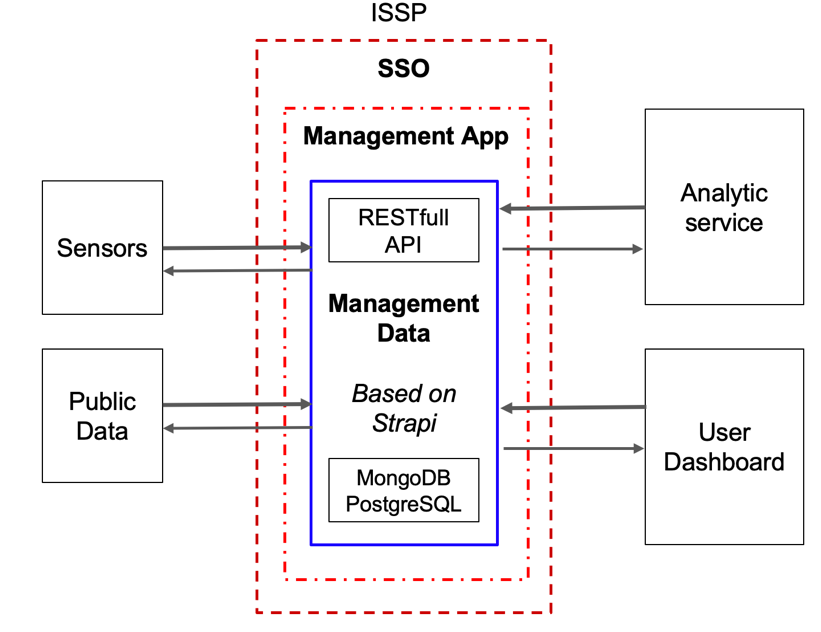
Source: Authors’ own
ISSP is protected by a credential manager with a single sign-on in the first layer. This single sign-on makes it easier for city governments to access public services by utilising the open-source Keycloak. The Restful API integrates data gathered from various public sensors. PostgreSQL is used to store the integrated data. The stored database is then analysed by analytics services. Python is used to develop the analytics services.
After the implementation, the evaluation could be as follows.
- ISSP has been able to combine two official population and health data sets.
- Implementing user integration within the city’s internal environment allows up to five users to access public services using a single account.
- The dashboard in one of the health and population-related domains signals that dashboard visualisation has been implemented.
The system could help local governments in making decisions, which results from the implementation of the ISSP.[11] A data example that contains marital status, birth conditions, illness during pregnancy from the regional health summary could demonstrate how the risk of infant mortality could be reduced based on the findings of the ISSP monitoring programme. Such monitoring could reduce the number of infant deaths in a given area. Public information that has been anonymised is known as published information. The only owner of this comprehensive information would be the regional health office.
Attribution: Okyza Maherdy Prabowo et al., “DPI for Improved Public Service: Lessons from Indonesia’s Integrated Smart System Platform,” T20 Policy Brief, July 2023.
Endnotes
[1] Emily, Royal. Building & Securing Digital Public Infrastructure: A Playbook for Local and Regional Governments. Kenya: United Nations Human Settlements Programme, 2020.
[2] Akashi H, Ishizuka A, Lee S, Irie M, Oketani H, Akashi R, “The role of the G20 economies in global health,” Glob Health Med. 2019 Oct 31;1(1):11-15. doi: 10.35772/ghm.2019.01008. PMID: 33330748; PMCID: PMC7731051.
[3] Christel M. “Pharm Exec’s Top 50 Companies 2017,” Pharmaceutical Executive, accessed 6 April 2023
[4] UNDP, “The Social and Economic Impact of Digital Public Infrastructure based on Digital Public Goods,” New York: Digital Public Goods Alliance, 2022.
[5] The Rockefeller Foundation,“Co-Develop Digital Public Infrastructure for an Equitable Recovery,” Norwegian: Digital Public Goods Alliance, 2021.
[6] Ketja Bego, “Towards Public Digital Infrastructure: A Proposed Governance Model,” Europe: NGI Forward, 2022.
[7] Rossignol Ivan, and Luke Jordan, “Digital Infrastructure Financing: Issues, Practices and Innovations G20 Compendium of Case Studies,” Beijing: G20 and Asian Infrastructure Investment Bank, 2022.
[8] Poreira, Jorge et al., “A Platform for Integrating Heterogeneous Data and Developing Smart City Applications,” Future Generation Computer Systems, volume. 128 (2022): 552-556.
[9] Nesi, Paolo et al., “An Integrated Smart City Platform,” (2018): 171-176.
[10] Osman, Ahmed M Shahat, “A Novel Big Data Analytics Framework for Smart Cities,” Future Generation Computer Systems, volume. 91 (2019): 620-633.
[11] Diskominfo, “Kick Off Implementasi Integrated Smart System Platform,” Accessed April 6, 2023.
